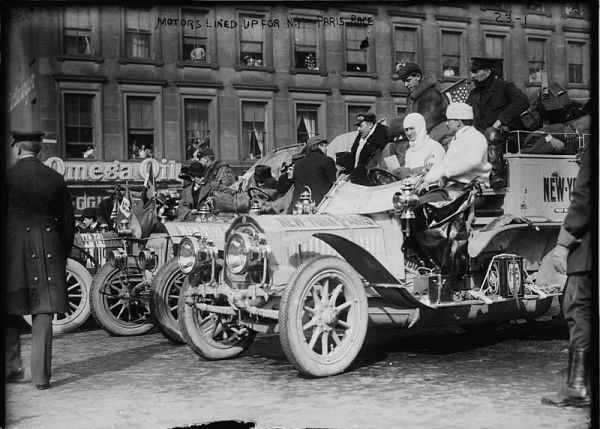
It involved only a half-dozen cars and 17 men, but this was one race that not only made history -it changed it.
GET A HORSEIn 1908, the promise of the automobile was just that -a promise. The industry was in its infancy, and most people still relied on horses or their own two feet to get from one place to another. Skeptics were convinced that the automobile was just an expensive and unreliable gimmick. So how could anyone prove to the world that the automobile was the most practical, durable, and reliable means of transport ever invented? Easy: Sponsor a race. But not just any race- it would have to be a marathon of global proportions, pitting the newfangled machines (and their drivers) against the toughest conditions possible on a course stretching around the world, with a sizable cash prize to the winner, say, $1,000. Then call it “The Great Race” …and cross your fingers.
MY CAR’S BETTER THAN YOURS
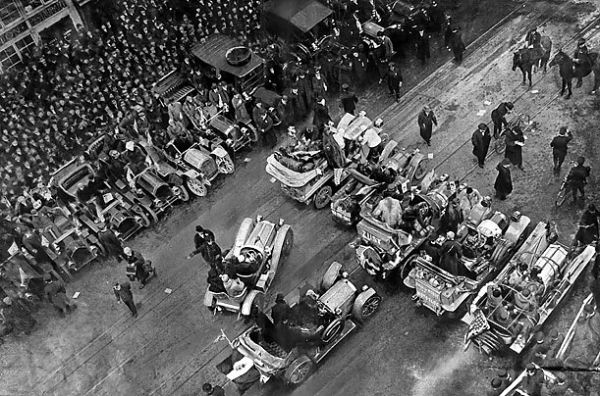
The starting line in Times Square.
Few paved roads existed anywhere at that time, and much of the planned route crossed vast roadless areas. And with few gas station in existence, just completing the course would require every ounce of stamina and ingenuity on the part of the car and the driver, but the winner would own indisputable bragging rights to the claim of the Best Car in the World.
GENTLEMEN, START YOUR ENGINES
THEY’RE OFF!
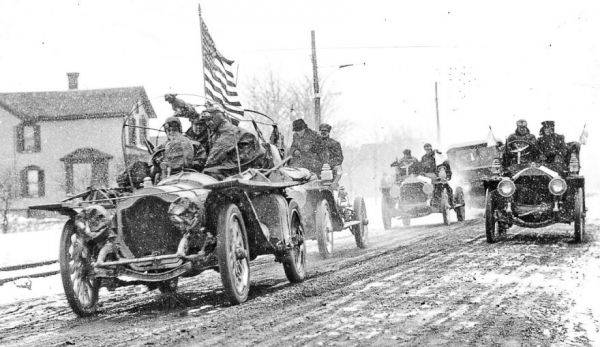
After Chicago, the cars headed out across the Great Plains in subzero temperatures. To keep warm, the French Motobloc team rerouted heat from the engine into the cab (an innovation that found its way into future cars) but to no avail; The Motobloc had to quit the race in Iowa. Meanwhile, the winter weather had turned the plains into mud, which stuck to the chassis of the cars, adding hundreds of pounds to the weight of each vehicle. Teams took to stopping at fire stations in every town they passed for a high-pressure rinse.
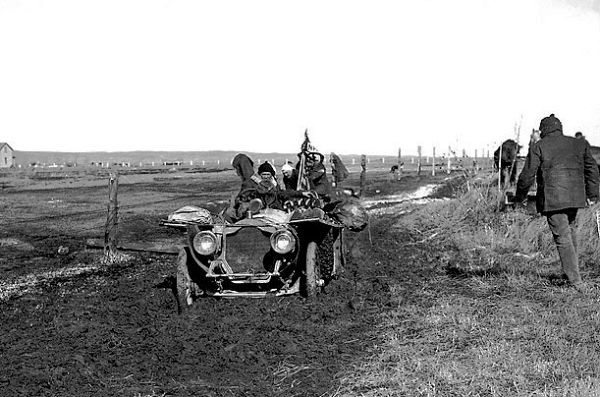
When there were non train tracks, the cars used ruts left by covered wagons years before. They navigated by the stars, sextants, compasses, and local guides, when they could hire them. And if they had to stop for more than a few hours, the radiators had to be completely drained -antifreeze hadn’t been invented yet.
TAKING THE LEAD
After 41 days, 8 hours, and 15 minutes, the Thomas Flyer was the first to reach San Francisco, becoming the first ever car to cross the United States in winter. The American team promptly boarded a steamer to Valdez, Alaska, the starting point for the overland trip to the Bering Sea, and brought a crate of homing pigeons with them to send reports back to the States. Race organizers had hoped the ice across the Bering Strait would provide a bridge for the cars. But the Alaska leg had to be scrapped because the weather and driving conditions were even worse than they’d been in the United States. (The pigeon plan didn’t work so well, either. The first bird sent aloft from Valdez was attacked and eaten by seagulls.)
The U.S. team was given a 15-day bonus for their Alaskan misadventure and told to return to San Francisco to join the other racers on the S.S. Shawmutt, bound for Yokohama, Japan. At the same time, the German team was penalized 15 days for putting their car on a train from Ogden, Utah, to San Francisco. Both decisions would bear heavily on the race’s end.
GENTLEMEN, RESTART YOUR ENGINES
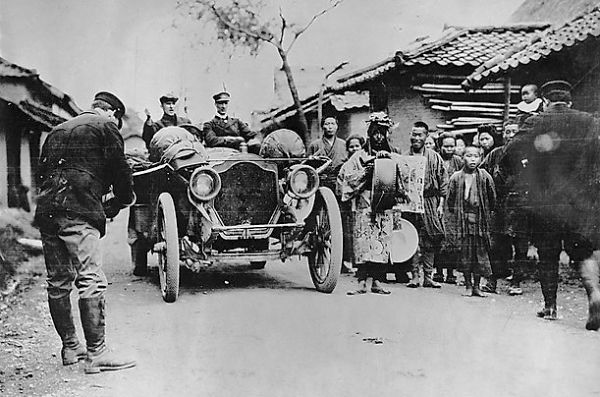
The Thomas Flyer in China.
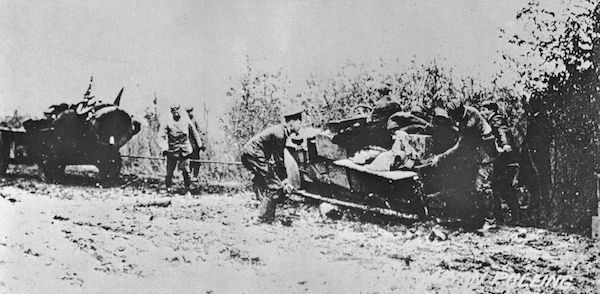
HUMAN OBSTACLES
Road conditions in Siberia were even worse than they’d been in the western United States. Once again the cars took to the rails- this time of the tracks of the Trans-Siberian Railway. An attempt by Schuster to use a railroad tunnel could have been scene from a silent movie comedy, as the American car frantically backed out of the tunnel ahead of an oncoming train. There were other obstacles, too. At one point the American team was charged by a band of horsemen brandishing rifles. The Americans burst into laughter and drove right through the herd of riders, leaving the bandits in the dust.
Driving around the clock created other problems: The relief driver often fell out of the open car while sleeping, so the team fashioned a buckle and a strap to hold him in- the world’s first seat belt. The length and rigor of the race took its toll as well, and tempers flared. At once point an exasperates Schuster threatened to throw Hansen out of the car and off the team. Hansen responded by pulling his pistol and snarling, “Do that and I will put a bullet in you.” Mechanic George Miller drew his gun and snapped, “If any shooting is done, you will not be the only one.” Finally both sides agreed to holster their weapons and press on.
ITALIAN TRAGEDY
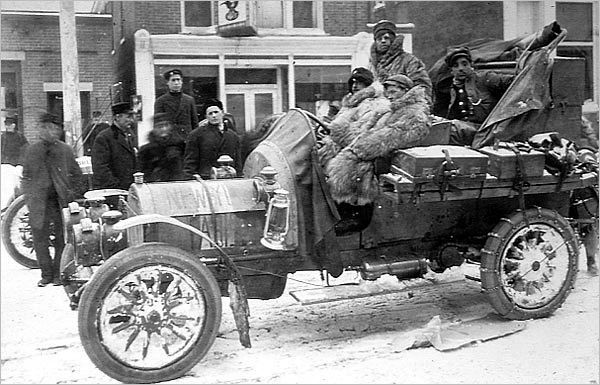
The Italian Zust at the beginning of the Great Race.
By
May the cars had been racing around the world for four months. The
quicker German Protos had pulled ahead of the American Thomas Flyer,
while the underpowered Italian Zust fell farther and father behind but
pressed on, convinced they’d catch up. Then disaster struck. Outside
Tauroggen, a Russian frontier town, a horse drawing a cart was startled
by the sound of the passing Zust and bolted out of control. A child
playing near the road was trampled and killed. The Italians drove into
Tauroggen to report the accident and were promptly thrown in jail, where
they remained for three days, unable to communicate with anyone
outside. Finally, the local police determined the driver of the cart was
at fault for losing control of his horse, and released them. They
continued on to Paris in a somber mood.
AND THE WINNER IS…
AND THE WINNER IS…
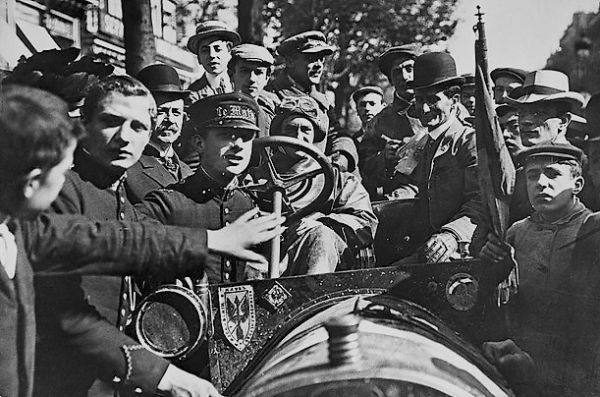
The German Protos in Paris.
On
July 30, 1908 -169 days after the race’s start- the Thomas Flyer
arrived on the outskirts of Paris, smelling victory. The Protos had
actually gotten to Paris four days earlier, but because of the
American’s 15-day bonus and the German’s 15-day penalty, everyone knew
the American team had an insurmountable margin of victory. Or did they?
Before the Americans could enter the city, a gendarme stopped
them. French law required automobiles to have two working headlights.
The Flyer had only one; the other had been broken back in Russia (by a
bird). A crowd gathered.
Parisians, like thousands of others around the world, had been following the progress of the Great Race for months in the papers. They were anxious to welcome the victors at the finish line on the Champs-Elysées.
Schuster’s crew pleaded with the gendarme, but he wouldn’t budge. No headlight, no entry. A frustrated Schuster was about to set off an international incident by attacking the gendarme when a bicyclist offered the Americans a headlamp from his bike. Mechanic Miller tried to unbolt the light but couldn’t pry it off. The solution: they lifted the bike onto the hood of the car and held it in place by hand. The gendarme shrugged his shoulders and waved them on. A few hours later they crossed the finish line. Victory at last!
A NEW ERA BEGINS
Parisians, like thousands of others around the world, had been following the progress of the Great Race for months in the papers. They were anxious to welcome the victors at the finish line on the Champs-Elysées.
Schuster’s crew pleaded with the gendarme, but he wouldn’t budge. No headlight, no entry. A frustrated Schuster was about to set off an international incident by attacking the gendarme when a bicyclist offered the Americans a headlamp from his bike. Mechanic Miller tried to unbolt the light but couldn’t pry it off. The solution: they lifted the bike onto the hood of the car and held it in place by hand. The gendarme shrugged his shoulders and waved them on. A few hours later they crossed the finish line. Victory at last!
A NEW ERA BEGINS
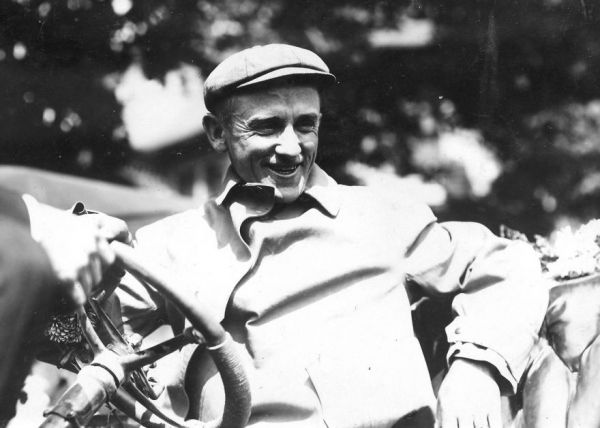
George Schuster in Paris.
The
celebrations lasted for weeks, long enough for the Italian team, weary
but unbowed to roll into Paris on September 17 and take third place. The
Great race was officially over. The drivers and their crews became
national heroes in their home countries. When the Americans got back to
New York, they were given a ticket tape parade down Fifth Avenue and
invited by President Theodore Roosevelt (the first U.S. president to
drive a car) to a special reception at his summer house on Long Island.
Today the Thomas Flyer is on display in Harrah’s Automobile Collection
in Reno, Nevada. Munich’s Deutsches Museum has the German Protos. The
Italian Zust was destroyed in a fire only months after the race, but the
ultimate fates of the cars involved didn’t matter. All three finishers
had proved that a car could reliably and safely go anywhere in the world
at any time, and under any conditions. No other form of transport could
make the same claim. With the conclusion of the Great Race, the
Automobile Age had finally arrived. That same year, Henry Ford put the
Model T into full production on the assembly line, and the world has
been car-crazy ever since.

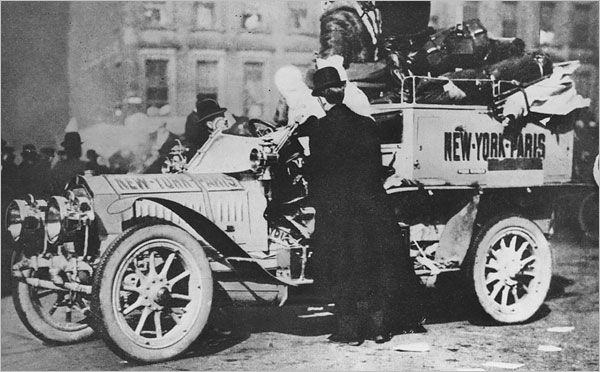
No comments:
Post a Comment